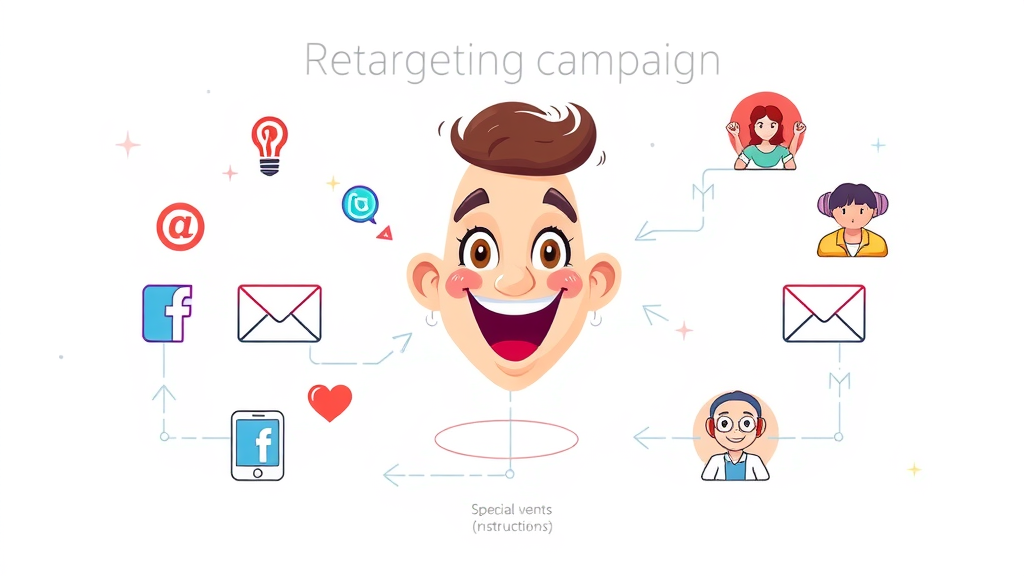Did you know nearly 98% of website visitors leave without converting? If you’re watching valuable traffic vanish from your landing page or product page, you’re not alone. But here’s the game changer: retargeting strategies help flip that statistic, re-engaging lost prospects and driving measurable ROI. In this guide, discover how today’s top digital brands use advanced retargeting ads on social media, display networks, and beyond to not just win back their audience—but to boost conversions unlike ever before.
Unlocking Success: Why Retargeting Strategies Dominate Modern Digital Marketing
-
Nearly 98% of website visitors leave without converting —retargeting strategies can change that narrative by re-engaging lost prospects and driving measurable ROI.

-
Discover how to use advanced retargeting strategies and retargeting ads to win back and convert your audience across social media and beyond.
Today’s digital marketing landscape is more competitive than ever, with brands vying for the attention—and wallets—of every potential customer. Retargeting strategies stand out because they focus your ad campaign budget on people who have already shown interest, making conversions much more likely. These strategies, from media retargeting to dynamic retargeting ads , are increasingly used by experienced marketers to boost ROI across platforms like Facebook, Instagram, and Google’s Display Network. Practical examples include re-engaging someone who abandoned a shopping cart or nudging a recent site visitor back toward your landing page. Whether you’re a small business or a large enterprise, retargeting campaigns help keep your brand top of mind, maximize your ad dollars, and spark conversions that might otherwise be lost.
Elevate Campaign Performance with Retargeting Strategies: Key Lessons You'll Learn
-
The foundational principles of retargeting strategies and how they work
-
Step-by-step setup for successful retargeting campaigns
-
Best practices for media retargeting and dynamic retargeting ads
-
Techniques for leveraging social media retargeting and email retargeting

-
How to optimize retargeting ad performance and conversion rates
-
Real-world examples and actionable tips for your ad campaign
Retargeting Strategies Overview: Transforming the Modern Ad Campaign
Defining Retargeting Strategies: From Retargeting Ad to Retargeting Campaign
-
Comparison of retargeting strategies and regular ad campaigns
-
How retargeting ads keep your brand top-of-mind

Retargeting strategies differ from regular ad campaigns by focusing your messaging on audiences that have already interacted with your brand. Unlike a generic display ad served to broad audiences, a retargeting ad zeroes in on people who have, for example, visited your site, viewed a product page, or almost completed a shopping cart. This approach helps brands stay top of mind for site visitors, using digital marketing techniques that target with greater personalization and relevance than traditional display ads. Not only does this increase conversion rates, but it also stretches your marketing budget further by prioritizing audiences more likely to convert.
Regular ad campaigns seek new audiences, trying to catch interest with broad targeting. In contrast, retargeting ads serve as reminders, gently nudging those who already showed a level of intent—keeping your brand at the forefront during their buying journey. By using cookies, pixels, and advanced segmentation, your retargeting work builds a pipeline of warm leads perfectly positioned for a second marketing push, directly addressing the needs and behaviors of each unique segment.
The Power of Retargeting Campaigns on Social Media Retargeting Platforms
-
Social media retargeting versus display network retargeting
-
Role of custom audiences in enhancing retargeting ad effectiveness
|
|
|
Comparison: Retargeting Types, Campaign Goals, Example Platforms |
|
Retargeting Type |
Campaign Goal |
Example Platform |
|---|---|---|
|
Site-Based Retargeting |
Bring website visitors back for purchase/completion |
Google Display Network, AdRoll |
|
Dynamic Retargeting |
Personalized product ads based on prior views |
Facebook, Instagram |
|
Social Media Retargeting |
Re-engage on social channels, boost brand awareness |
Facebook, Instagram, Twitter |
|
Email Retargeting |
Win back via strategic, contextual messaging |
Mailchimp, HubSpot |
Social media retargeting platforms, such as Facebook and Instagram, can capture users throughout their online journey—not just when they re-visit your site. By leveraging custom audiences built from pixel-tracked site visitors or uploaded email addresses, a retargeting campaign can deliver precise, tailored ads that speak directly to your target audience. This level of audience segmentation ensures that your social media retargeting ads match user interests, stage in the buying funnel, and even their device preference, boosting click-through and conversion rates.
Comparatively, display network retargeting campaigns serve ads across a web of partner sites, reinforcing your message after a website visit. The real magic happens when you integrate social media and display networks, creating a seamless, omnichannel retargeting workstream. This constant yet curated exposure keeps your brand top of mind —turning one-time visitors into loyal customers via a systematic, data-driven marketing strategy.
Types of Retargeting: Choosing the Right Retargeting Strategy for Your Target Audience
Site-Based Retargeting Ads: Fundamentals and Use Cases
Site-based retargeting is the foundation of most modern retargeting strategies . This approach involves using tracking pixels or cookies to follow users after a website visit. When visitors leave your landing page without completing a purchase or other marketing goal, the technology enables your retargeting ads to appear across countless partner websites and platforms as display ads. This ‘reminder’ strategy reignites interest and encourages return visits, making it a cornerstone of any high-performing ad campaign.
Use cases include recovering abandoned shopping carts, promoting seasonal discounts, or driving users back to high-value product pages. With site-based retargeting, you can customize messaging based on pages visited or actions taken, giving each segment a unique path back through your marketing funnel. Whether you’re re-engaging a first-time visitor or nudging a warm lead to purchase, this retargeting work builds a tailored, dynamic follow-up sequence proven to increase conversions and ROI.
Dynamic Retargeting: Why Personalization Wins
Dynamic retargeting takes personalization to the next level by serving retargeting ads showing the exact products or services a user viewed on your site. When a potential customer browses a product page and leaves, dynamic retargeting ensures the same items (or closely related products) follow them across display networks and social media. The essence of dynamic retargeting lies in its ability to create a unique, relevant ad experience for every single prospect, directly tapping into their demonstrated interests and intent.
This strategy is especially effective for e-commerce brands and large catalogs—users are much more likely to return and convert when they see ads featuring what they already want. Real-time product feeds and behavioral signals make dynamic retargeting a powerful tool for both media retargeting and social media retargeting. By turning data into instantly actionable creative, brands can dramatically boost click-through and conversion rates for their entire target audience.

Social Media Retargeting: Leveraging Facebook Ad and Instagram for Retargeting Campaigns
Social media platforms like Facebook and Instagram are critical stages for executing high-impact retargeting campaigns. With billions active daily, your retargeting ad can engage users not just after they leave your site but also as they browse their newsfeeds. With advanced targeting, brands can push reminders, offer timely deals or drive users back to their landing page with lower friction and higher personalization. For example, a Facebook ad can be tailored based on the specific product, content, or category a user interacted with, making each engagement feel personal and highly relevant.
Furthermore, social media retargeting supports cross-device visibility—prospects can see your dynamic retargeting ad on their desktop in the morning, and again on mobile later in the day. By using custom audience segmentation and robust analytics, marketers can continually refine ad campaigns for optimal frequency and impact. Harnessing these platforms ensures consistent exposure and maximizes every opportunity to convert site visitors who have already demonstrated clear interest.
Email Retargeting: Re-Engaging with Strategic Messaging
Email retargeting remains a cornerstone of digital marketing, despite the rise of newer channels. Retargeting emails can possibly achieve an impressive 30% average conversion rate , significantly outperforming the usual conversion rate, which typically falls below 5%. (Source: SaleCycle) After capturing a user’s email address—often via sign-up forms, content downloads, or abandoned cart pop-ups—marketers can deploy strategic, automated emails that reignite interest and drive conversions. These include reminders, personalized recommendations, or special incentives, all tailored to a user’s behavior and stage in the funnel. When email retargeting is combined with other media retargeting channels, its effectiveness multiplies, offering multiple touchpoints and reinforcing brand recall with your target audience.
Best practices for email retargeting include segmenting by action (e.g., abandoned cart vs. browsed products), A/B testing creative and subject lines, and aligning send times with user activity. The precision and intimacy of email make it perfect for delivering nuanced, contextual messaging—especially when retargeting work is integrated across platforms. Effective email retargeting moves site visitors from curiosity to purchase, nurturing long-term brand relationships in the process.
List-Based Retargeting and Custom Audiences
List-based retargeting involves uploading a list of customer identifiers—usually email addresses or phone numbers—into platforms like Facebook, Google, or LinkedIn to create custom audiences for tailored ad delivery. This strategy allows campaigns to stay connected with leads or previous customers who haven’t visited your site recently, extending the reach of your marketing strategies beyond standard retargeting channels.
With list-based custom audiences, you can build segments by past purchases, lead scores, or engagement history, ensuring the right message reaches each recipient. Marketers can trigger hyper-personalized campaigns via both social media retargeting and email retargeting, maintaining relevance and increasing the odds of re-engaging high-potential segments. In B2B or high-ticket retail in particular, list-based retargeting transforms dormant contacts into qualified, conversion-ready opportunities.

|
|
|
Pros and Cons of Each Retargeting Strategy |
|
Strategy |
Pros |
Cons |
|---|---|---|
|
Site-Based Retargeting |
Broad reach, automation, effective reminders |
Less personalization, ad fatigue risk |
|
Dynamic Retargeting |
Highly personalized, high conversion rates |
Tech complexity, potential privacy concerns |
|
Social Media Retargeting |
Cross-device reach, robust targeting |
Ad blindness, platform dependency |
|
Email Retargeting |
Direct, cost-effective, high engagement |
Email fatigue, list decay |
|
List-Based/Custom Audiences |
Precision targeting, reactivates dormant users |
Data accuracy, scaling limitations |
How Retargeting Strategies Work: Behind-the-Scenes of Retargeting Ads
Understanding Pixels, Cookies, and User Segmentation in Retargeting Campaigns

Retargeting strategies rely on a blend of technologies to identify, track, and re-engage audiences. Pixels and cookies are set when a user visits your website or landing page, enabling ad platforms to follow their browsing behavior. This backend retargeting work allows for segmentation by time spent, pages viewed, device type, and more, so each ad campaign is carefully tailored to target audience interests and likelihood to convert. Without these essential building blocks, the precision and impact of retargeting ads wouldn’t exist.
User segmentation takes this even further; by sorting site visitors based on actions (like visiting a product page vs. abandoning a shopping cart), you can serve differentiated, hyper-relevant ad content. Pixels and cookies also enable measurement and attribution, helping marketers link every conversion and engagement back to the original touchpoint in the user’s journey, optimizing future retargeting campaigns for even stronger ROI.
Optimizing Ad Campaign Delivery for Different Custom Audiences
"Retargeting turns intent into action by serving highly relevant ads to users who already know your brand." – Digital Marketing Expert
-
Why tracking user behavior leads to higher conversion rates
-
Best practices for segmenting your target audience
Successfully delivering retargeting ads hinges on understanding and segmenting your custom audience. Sophisticated marketers monitor behavioral signals, from time on site to interactions with display ads or product pages, creating tiers of user interest. By splitting audiences (such as high-intent vs. window-shoppers), you craft offers and creative designed to resonate with each group’s motivation and stage in the funnel.
Other best practices include frequency capping to avoid ad fatigue, analyzing cross-channel journeys for cohesive storytelling, and syncing messaging with seasonal marketing goals. Continual optimization based on real-time data—such as click-through rates or cost per acquisition—ensures you’re efficiently moving each segment along the path to conversion.
Building Profitable Retargeting Campaigns: Step-by-Step Guide
Setting Up Your Retargeting Ad Infrastructure

Establishing a strong infrastructure is key to successful retargeting work. Start by selecting a platform—such as Facebook Ads Manager, Google Ads, or a third-party tool—and implementing the proper tracking pixels or tags site-wide, especially on your most valuable landing pages and product pages. Ensure all privacy policies are up to date and cookie consent is clear to comply with regulations. Once tracking is in place, segment your site visitors by crucial actions, such as initiating checkout, viewing a specific product, or spending above-average time on site, so you can deliver tailored Messages that maximize intent.
Organize your retargeting campaign structure for scalability: name ad sets clearly, group by audience segment, and establish baseline budgets. Don’t forget to test your pixel deployment and tracking tags with analytics tools to ensure every impression is captured accurately. Robust campaign architecture paves the way for high-performance retargeting strategies—and scalable, repeatable success.
Creating Impactful Ad Creative for Dynamic Retargeting and Social Media

Crafting high-quality, eye-catching ad creative is the next step in driving your retargeting strategies forward. For dynamic retargeting, use templates that can automatically populate with products a user viewed, ensuring immediate personalization. Social media retargeting campaigns benefit from bold visuals, concise copy, and clear calls-to-action tailored to move users down the funnel. Rotate creative frequently to fight ad fatigue and keep your brand experience fresh for repeat audiences.
Consider A/B testing various formats—carousel ads for multiple products, video snippets for engagement, or static banners for simplicity. The consistency in design across platforms and between your ads and landing page is crucial for seamless brand recall and reducing conversion friction. Ultimately, great creative connects emotionally, responds contextually to a user’s intent, and compels action in crowded digital arenas.
Advanced Tactics: Frequency Capping, Exclusions, and Sequencing
-
How to structure a multi-channel media retargeting strategy
Advanced retargeting tactics turn good campaigns into great ones. Frequency capping puts limits on how often ads are shown to the same user, combating oversaturation and maximizing available impressions for broader reach. Through exclusions, you can remove converted users or uninterested site visitors from further campaigns, improving efficiency and ad spend utilization.
Ad sequencing lets you deliver stories over time, such as showing an introductory ad on day one, a product-focused display ad on day three, and a special offer or testimonial on day five. Multi-channel media retargeting structures this progression across platforms and devices, keeping users engaged at every touchpoint and accelerating their journey to conversion. Building these layers intelligently is essential for brands seeking to lead, not just follow, in digital marketing innovation.
Maximizing ROI: Best Practices for Retargeting Strategies in 2024
Combining Social Media Retargeting and Email Retargeting for Omnichannel Impact

The most successful digital brands weave together social media retargeting and email retargeting for a true omnichannel experience. By aligning campaigns, messaging, and creative across channels, you increase frequency, brand recall, and the likelihood your target audience will act. For example, a user who abandoned a cart sees a dynamic Facebook ad, then receives an email nudge with a discount, maximizing touchpoints and driving urgency.
Integrating these channels means tracking engagement holistically, sharing insights between email and ad platforms, and personalizing each contact based on the latest behavior. When executed well, omnichannel retargeting strategies drive conversion rates far higher than siloed efforts, capitalizing on every interaction from first website visit to eventual purchase.
Audience Segmentation: Crafting Custom Audiences for Higher CTR and Conversions
Audience segmentation is the engine of high-performance retargeting strategies. Start with granular data: device used, site behavior, page visits, time since engagement, and purchase history. Retargeting tools often work together seamlessly with over 500 audience segments and multiple advertising networks, ( financeonline.com ) enhancing their reach and effectively use this information to build custom audiences —such as “viewed product but didn’t add to cart” or “engaged with blog, but never bought.” This degree of clarity unlocks messaging that feels personal and urgent, boosting click-through and conversion rates across all media retargeting channels.
Further refine with demographic factors, psychographics, and past campaign insights to ensure you’re reaching the most valuable prospects with every display ad, Facebook ad, or email retargeting touch. Better segmentation always equals better retargeting work, keeping your campaigns cost-effective while driving serious business results.
Optimizing Budget Allocation Across Retargeting Ads
-
Key industry benchmarks for retargeting campaign performance
Effective budget allocation is a hallmark of successful retargeting strategies . Review past campaign performance, focusing on KPIs like cost per acquisition (CPA), click-through rate (CTR), and conversion rate by channel. Allocate more spend to top-performing segments (such as high-intent product page viewers), while continuously testing smaller audiences for untapped potential. Benchmarks vary by industry but generally, retargeting CPA is 30-50% lower than prospecting campaigns, and retargeting conversion rates are often 2–3x higher.
Keep budgets agile. Set daily and lifetime caps, revise in response to seasonality or stock levels, and use real-time analytics to pivot spend instantly. This approach ensures maximum impact while safeguarding your ROI.
|
|
|
KPIs to Track in Your Retargeting Strategy |
|
KPI |
Why It Matters |
Benchmark |
|---|---|---|
|
Click-Through Rate (CTR) |
Gauge user engagement |
0.3 – 0.9% (Display) 1.0 – 2.5% (Social) |
|
Conversion Rate |
Measure campaign effectiveness |
2 – 4% on average |
|
Frequency |
Control ad fatigue, avoid oversaturation |
<10 views/user/month |
|
CPA (Cost Per Acquisition) |
Optimize cost efficiency |
30-50% lower than prospecting CPA |
|
ROAS (Return on Ad Spend) |
Evaluate financial performance |
>400% typical goal |
Common Pitfalls: What Makes a Retargeting Campaign Fail?
Oversaturation, Ad Fatigue, and Frequency Errors

One of the most common reasons a retargeting campaign fails is oversaturating site visitors, leading to ad fatigue. If your audience sees the same retargeting ad too many times, they’ll start tuning it out—or worse, develop a negative association with your brand. Avoid this by setting clear frequency caps and rotating creative. Monitor real-time data for signs of declining engagement, and be ready to adjust content, timing, or channel allocation to keep your retargeting work relevant and effective.
Other frequency errors include blanketing all custom audiences with the same messaging or missing subtle cues in behavior shifts. Instead, segment audiences by engagement level and test different ad sequences. This ensures a mix between persistent reminders and fresh creative, resulting in optimal conversion rates and positive brand recall.
Ignoring Custom Audience Quality and List Hygiene
High-quality custom audiences are the lifeblood of any profitable ad campaign. Over time, though, lists can stagnant or even degrade—email addresses go dormant, cookies expire, or interests shift. Poor data hygiene leads to wasted ad spend and misaimed messaging. Regularly audit and update your audiences, remove inactive segments, and ensure you’re using clean, recent data from your website and CRM.
When creating lookalike or list-based segments, verify that the source data reflects your actual ideal customer profile, not just the largest available pool. This practice enables your retargeting campaigns to reach the precise target audience most inclined to convert, increasing return on every ad dollar.
Lack of Personalization in Dynamic Retargeting Ads
-
Checklists to avoid common retargeting mistakes
Personalization is the foundation of successful dynamic retargeting , yet many marketers still rely on generic, one-size-fits-all messaging. Failing to customize your creative and offer based on user behavior means missed revenue—and potential customer frustration. Conduct regular reviews of your creative library, adjust product feeds for real-time relevance, and test personalized incentives or recommendations.
Final checklist: align ad creative with landing page content, ensure offers are fresh, segment audiences by recency and product viewed, and always, always rotate content to fight fatigue. When every touchpoint feels crafted for the recipient, your retargeting strategies outperform the competition every time.
Real-World Success: Case Studies of Winning Retargeting Strategies
E-Commerce: Skyrocketing Sales with Dynamic Retargeting

Consider a fashion e-commerce retailer struggling with high cart abandonment. By employing dynamic retargeting, they reintroduced abandoned products to users across Facebook and Google Display Network, while layering on a limited-time coupon code. The result? Cart recovery rates jumped 25%, and the average order value rose by nearly 18%. This campaign typified how personalization and persistence, when combined with strategic media retargeting, can dramatically elevate bottom-line results.
Integration with email retargeting added another dimension—users who didn’t convert via display ad saw a well-timed reminder in their inbox, pushing conversion rates even higher. For e-commerce brands, a holistic retargeting campaign of this kind turns browsing intent into tangible sales results, outperforming traditional display ads by a wide margin.
B2B: Large-Scale Retargeting Campaigns on Social Media
B2B companies face a longer buyer journey, but social media retargeting enables them to remain top of mind throughout. A SaaS provider segmented their custom audiences by funnel stage—awareness vs. interest vs. decision—and delivered educational content for top layers, then product demos and testimonials for those closer to conversion. Through LinkedIn and Facebook ad sequencing, the brand tripled qualified lead submissions at 40% less CPA. This approach proves that retargeting campaigns, when aligned with content and funnel stage, can transform long-lead sales into closed deals faster and cheaper than outbound tactics alone.
Robust analytics tracked each interaction, allowing real-time optimization of ad creative and budget allocation. The result was an automated, scalable system that nurtured leads until they were sales-ready, marking a new benchmark for media retargeting effectiveness in B2B marketing.
SaaS: Improving User Onboarding Through Email Retargeting
For SaaS startups, user activation is everything. Email retargeting sequences, triggered by onboarding activity (or inactivity), guide users back to unexplored features or help centers, increasing product adoption and reducing churn. One software platform used sequential emails tied to user in-app behavior: after sign-up but before first login, a personalized nudge; after login but before full setup, a feature highlight. This led to a 150% uptick in active usage within 30 days, and a 20% boost in trial-to-paid conversions.
"After implementing retargeting strategies, our cost per acquisition dropped by 40%." – Marketing Director, Ecommerce Brand
Expert Tips: Innovative Retargeting Strategies for Competitive Advantage
-
Leverage lookalike audiences for broader reach
-
Smart personalization in dynamic retargeting ads
-
Integrate cross-device retargeting for full-funnel impact
Stay ahead by constantly innovating your retargeting strategies. Test lookalike audiences to expand beyond your current segments, automating dynamic retargeting so messaging updates as inventory or promotions change. Use tools for cross-device targeting—ensuring your brand remains visible whether a user jumps from desktop to mobile or vice versa. By blending these tactics, you transition from simply ‘reminding’ visitors to actively moving them toward your desired marketing goal.
Competitive advantage comes down to one core truth: the more relevant, timely, and personal your retargeting work, the more conversions you’ll drive—today and tomorrow.
Frequently Asked Questions About Retargeting Strategies
What is a retargeting strategy?
-
A retargeting strategy is a digital marketing approach using retargeting ads aimed at re-engaging users who have previously visited your website or engaged with your social media properties, driving them to complete conversions.
What is a remarketing strategy?
-
A remarketing strategy is similar to a retargeting campaign but is often associated with email and Google Ads, helping businesses reconnect with previous visitors using personalized ads and messaging.
What is an example of retargeting?
-
An example of retargeting is when an online shopper abandons their shopping cart, and later sees a retargeting ad for the same products on social media or other websites, prompting them to return and purchase.
How can I do retargeting?
-
To do retargeting, set up tracking pixels on your website, develop targeted creative, segment your audience, and launch retargeting ads on platforms such as Facebook, Google, or your preferred social media channels.
Key Takeaways: Elevate Your Marketing with Smart Retargeting Strategies
-
Retargeting strategies should be an essential part of your ad campaign mix for maximum ROI.
-
Custom audiences enable precise targeting for improved conversion rates.
-
Dynamic retargeting and media retargeting build relevance and engagement.
-
Regularly optimize your retargeting campaigns using best practices and industry benchmarks.
Turn Insight into Action: Strengthen Your Retargeting Campaign Today
-
Ready to maximize your conversions and audience retention with proven retargeting strategies? Audit your current media retargeting, refresh your retargeting ads, or consult with a specialist to build your most effective ad campaign yet.
Get started on your next-level retargeting strategies: segment smarter, personalize your creative, and use data to maximize every conversion opportunity.
-
Struggling to make All of your M arketing Strategies Work Together Seamlessly and Effortlessly ? Omni-Channel or Cross-Channel, they Start with Content . Click the Link and Get our Ultimate Guide for Building a Content Marketing Strategy for Small Business..
To deepen your understanding of effective retargeting strategies, consider exploring the following resources:
-
“6 Retargeting Strategies to Boost Your Campaigns” ( ppchero.com )
This article provides actionable insights into creating personalized ad content, optimizing ad frequency and timing, and integrating retargeting with email campaigns to enhance your marketing efforts.
-
“Retargeting Marketing: Strategies for Effective Ad Campaigns” ( brandwatch.com )
This resource delves into advanced tactics such as sequential retargeting, lookalike audiences, and predictive targeting, offering a comprehensive guide to refining your retargeting campaigns.
By leveraging these expert insights, you can implement sophisticated retargeting strategies that re-engage lost prospects and drive measurable ROI.
 Add Row
Add Row  Add
Add 




Write A Comment